VR fitness games offer powerful benefits for people with cognitive disabilities by combining physical activity with immersive cognitive training. Games like Beat Saber, Job Simulator, and FitXR provide customizable experiences that improve motor skills, concentration, and memory while maintaining engagement through interactive environments. You’ll find these games enhance neuroplasticity and cognitive function through multi-sensory stimulation and adaptive difficulty levels. Discover how these accessible virtual environments can transform rehabilitation into an enjoyable, effective journey toward improved cognitive health.
Understanding Cognitive Disabilities and the Role of VR Fitness
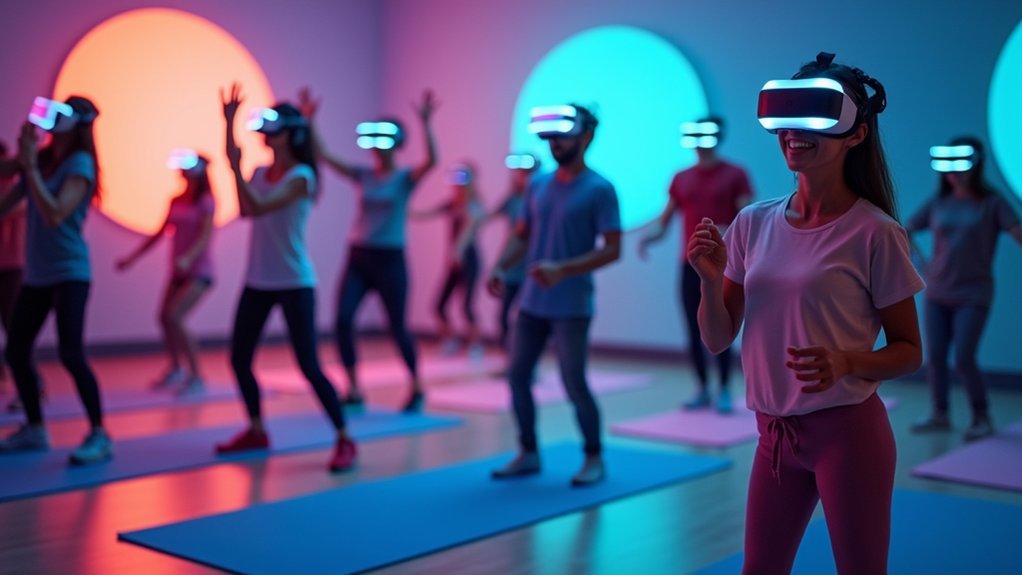
When we examine cognitive disabilities in depth, we find a diverse range of conditions that affect mental processing, learning, and daily functioning. These include autism spectrum disorders, ADHD, dyslexia, and conditions causing memory loss, affecting approximately 8% of undergraduate students.
The severity varies widely—mild cases typically show IQ scores between 55-70, moderate between 30-55, and severe below 30.
You’ll notice these individuals often struggle with independence, social interactions, and learning retention.
VR fitness offers promising solutions by enhancing motor skills and concentration while providing customizable, engaging environments. Studies show that personalization options significantly improve the experience for users with cognitive disabilities, allowing them to adjust interfaces based on their individual needs.
The interactive nature of VR can boost motivation during physical activities, making exercise accessible despite cognitive or mobility limitations.
This technology creates opportunities for consistent engagement while accommodating diverse needs through adaptive controls and clear guidance.
The Science Behind VR’s Impact on Cognitive Function
Your brain’s neuroplasticity works overtime when you use virtual reality fitness games, forming new pathways through immersive, multi-sensory experiences.
VR creates an ideal learning environment by engaging your visual, auditory, and kinesthetic senses simultaneously, strengthening cognitive connections more effectively than traditional therapies. Meta-analysis has shown that VR interventions yield moderate positive effects on overall cognition, particularly in attention, memory, and global cognitive function.
The immersive nature of VR can also help manage cognitive load by controlling stimuli and adjusting difficulty levels to match your specific cognitive abilities and rehabilitation needs.
Neural Plasticity Activation
As users immerse themselves in virtual reality fitness games, significant neurobiological changes occur beneath the surface. Your brain’s remarkable plasticity allows it to reorganize neural networks in response to these new virtual experiences, enhancing cognitive performance across multiple domains.
VR activates your brain through thorough sensory stimulation, promoting neural engagement that increases cortical gray matter volume and improves neuronal integration. These immersive environments stimulate adaptive mechanisms in the brain, strengthening neural pathways essential for cognitive rehabilitation.
| Brain Wave | Effect | Cognitive Impact |
|---|---|---|
| Alpha Wave | Enhanced relaxation | Improved attention |
| Beta Wave | Higher concentration | Better cognitive control |
| Neural Oscillations | Increased brain excitability | Enhanced learning potential |
These neurobiological adaptations are particularly beneficial if you’re experiencing cognitive disabilities, as VR creates safe, controllable environments that stimulate multiple cognitive domains simultaneously while tailoring challenges to your specific needs.
Immersive Learning Pathways
The science behind VR’s effectiveness lies in its unique ability to create immersive learning pathways that reshape cognitive processing. When you engage with VR environments, your brain processes information through dual-channel systems—combining verbal and visuospatial stimuli that enhance cognitive complexity.
You’re not just passively receiving information; you’re actively participating in visuomotor adaptation that strengthens connections between visual inputs and motor responses. This real-time feedback loop allows you to correct actions immediately, reinforcing proper cognitive pathways.
The entertainment value of VR fitness games isn’t just for enjoyment—it’s an essential mechanism that maintains your engagement, particularly if you’re experiencing mild cognitive impairment. The sensory-rich environment in VR triggers neuroplastic changes that support the formation of new neural connections necessary for cognitive improvement.
These immersive environments target multiple cognitive functions simultaneously, including working memory, attention, and executive function, creating thorough neural stimulation that traditional training methods simply can’t match.
Cognitive Load Management
Utilizing virtual reality fitness games effectively requires understanding how cognitive load works in these immersive environments.
When designing for individuals with cognitive disabilities, you’ll need to balance different types of mental demands.
VR’s multimodal interfaces can reduce extraneous load by engaging multiple senses simultaneously, freeing up mental resources for learning physical movements.
You’ll see better results when the environment minimizes distractions while maximizing germane load—the type that enhances skill acquisition.
For users with cognitive disabilities, measuring perceived difficulty provides valuable ground truth for customizing experiences.
Remember that social elements, while engaging, may increase cognitive demands through additional social cues.
Your fitness games should strategically manage this balance, adjusting difficulty based on real-time physiological measurements when possible to maintain ideal performance and learning outcomes.
Research shows that experts consistently demonstrate lower cognitive load than novices when performing similar tasks, suggesting the importance of progressive difficulty scaling in VR fitness applications.
Top VR Fitness Games for People With Intellectual Disabilities
Five remarkable VR fitness games have emerged as particularly beneficial for individuals with intellectual disabilities, combining physical activity with cognitive engagement in accessible formats. These games support longer exercise duration while maintaining motivation through immersive environments. Users should consult their doctors before starting these VR fitness programs, especially those with pre-existing conditions.
- Beat Saber – Offers rhythmic sword-slicing gameplay with adjustable difficulty levels that can be played while seated, making it ideal for users with varying physical capabilities.
- Job Simulator – Provides humorous, simplified task simulations that engage cognitive skills without overwhelming complexity.
- FitXR (formerly BoxVR) – Delivers structured cardio workouts that combine rhythm and movement, with customizable intensity that’s adaptable for different cognitive abilities.
Games with WalkinVR Driver support further enhance accessibility through controller assistance and alternative control schemes.
How VR Exergaming Combines Physical Activity With Cognitive Training
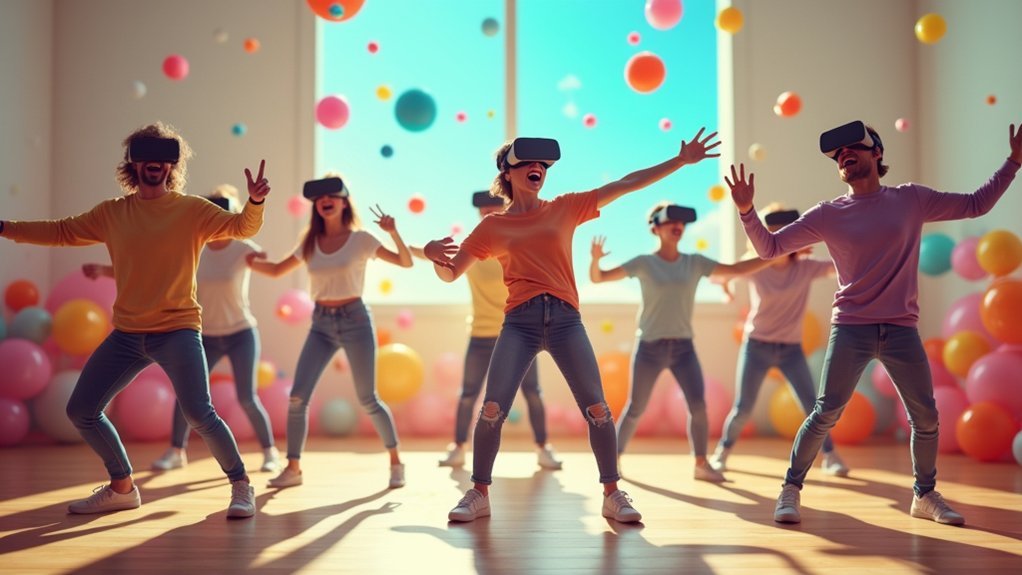
Virtual reality exergaming represents a groundbreaking intersection where physical movement meets cognitive stimulation, offering unique benefits beyond what traditional exercise or cognitive training can provide separately.
These immersive experiences simultaneously engage your body and mind, challenging executive functions, attention, and visual-spatial abilities.
When you participate in VR exergames, you’re not just moving your body; you’re traversing complex virtual environments that require quick decision-making and cognitive processing.
The immersive nature creates a stronger sense of presence, which enhances cognitive engagement and leads to measurable improvements in frontal executive functions.
Unlike conventional training, VR’s interactive elements reduce monotony, increasing your adherence to rehabilitation programs.
The benefits accumulate over time—while a single session may show limited effects, consistent participation leads to significant cognitive enhancements, especially for those with cognitive disabilities. Recent research has shown that optimal results come from engaging in three sessions weekly over a multi-week intervention period.
Success Stories: Real-World Benefits for Users With Cognitive Impairments
You’ll find compelling evidence in both individual transformation stories and scientific research showing VR fitness games’ positive impact on cognitive impairments.
Users with autism, Down syndrome, and dementia have experienced measurable improvements in attention, memory, and executive function through consistent VR exergaming.
Research confirms these anecdotal successes, with studies demonstrating significant cognitive gains compared to traditional therapies. Individuals with ADHD have shown particularly promising results, with VR environments helping them maintain focus during exercise and addressing symptoms through engaging physical activity.
User Transformation Stories
Behind every technological advancement in VR fitness lies a personal journey of transformation.
Take Bobby, who successfully managed his ADHD through HOLOFIT, discovering that immersive VR environments helped maintain his focus while improving physical health.
Users with cognitive disabilities frequently report three key benefits:
- Enhanced engagement and sustained motivation through dynamic, customizable VR worlds that prevent the boredom often challenging those with cognitive impairments.
- Improved confidence as they complete workouts and track progress, creating positive effects that extend beyond gaming sessions.
- Reduced stress and anxiety while experiencing cognitive improvements, particularly when using physically demanding applications like VR boxing.
These transformations demonstrate VR’s unique ability to address both physical fitness and cognitive function simultaneously, offering a thorough approach to wellness that traditional exercise often can’t provide. Many users with cognitive disabilities have found that WalkinVR Driver significantly expands their access to beneficial VR fitness experiences, regardless of their physical limitations.
Research-Backed Results
While individual success stories provide compelling anecdotal evidence, rigorous scientific research now confirms VR’s effectiveness for users with cognitive impairments. Studies reveal a significant improvement in cognitive function with a moderate effect size (Hedges’s g = 0.42), outperforming standard training programs.
You’ll benefit most when VR combines physical and cognitive challenges simultaneously. This dual-task approach enhances both global cognition and physical function while making exercise more enjoyable. Research from a recent study showed that older adults with mild cognitive impairment demonstrated significant improvements in global cognition (p=0.045) after VR-based cognitive training. Research shows users engage longer and with greater intensity during VR exergaming sessions.
The technical aspects matter too. High usability scores (77.96–82.66 on the System Usability Scale) indicate these platforms are accessible and well-received.
When designed thoughtfully, VR fitness games create engaging experiences that reduce cognitive decline and promote healthier lifestyles for those with cognitive disabilities.
Setting Up an Accessible VR Fitness Environment at Home
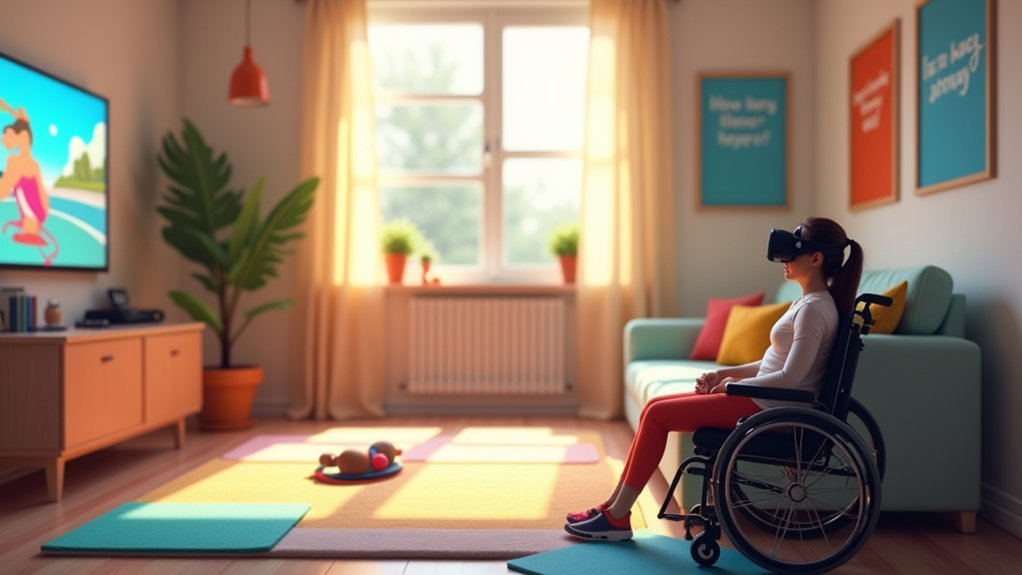
Creating an accessible VR fitness environment at home requires thoughtful planning and organization to accommodate cognitive disabilities.
Start by establishing a well-ventilated, well-lit space of at least 2×2 meters with non-slip flooring to prevent accidents during exercise.
Choose equipment that offers adaptability for different cognitive needs:
- Select a Meta Quest headset paired with fitness apps like HOLOFIT or Beat Saber that offer adjustable difficulty levels.
- Install washable facial interfaces and sweatbands for comfort and hygiene during intense workouts.
- Configure clear room boundaries through the companion app to prevent collisions and create a safe exercise zone.
Remember to customize the VR interface with clear visual and audio cues that match the user’s specific cognitive abilities and preferences. Consider adding weighted vests to enhance workout intensity as they can provide resistance training benefits while using VR fitness games.
Overcoming Barriers: Making VR Fitness Inclusive for All Abilities
The promise of VR fitness extends far beyond standard home setups—it holds potential for users across the cognitive disability spectrum. To realize this potential, you’ll need to address several key barriers.
Consider customizable hardware with adjustable straps and alternative input options like voice commands for those with limited dexterity. Haptic feedback integration can provide essential tactile sensations for visually impaired users, while intuitive interfaces with clear, adaptable designs support those with cognitive challenges. Brain-computer interfaces could revolutionize access for those with severe mobility limitations by allowing navigation through thought alone.
Adaptive hardware and sensory modifications transform VR fitness from exclusive technology into universally accessible opportunity.
Don’t overlook the financial hurdles—look for cost-effective solutions or community programs offering access to VR fitness equipment.
The most successful inclusive VR environments reduce cognitive load without sacrificing engagement, creating experiences that adapt to your abilities rather than forcing adaptation to rigid systems.
Measuring Progress: Tracking Cognitive and Physical Improvements
As you commence on your VR fitness journey, tracking both cognitive and physical improvements becomes essential for maintaining motivation and measuring real outcomes.
Modern VR systems collect extensive data across multiple domains, offering you insights into your progress.
Research confirms VR-based interventions yield significant cognitive benefits, with studies showing moderate effect sizes (Hedges’s g = 0.42) for cognitive improvement.
You’ll notice gains particularly when:
- Monitoring cognitive metrics through tools like the Enhance VR Performance Index that summarizes progress across cognitive categories
- Tracking physical data including heart rate and exercise duration during VR exergaming sessions
- Analyzing behavioral patterns such as reaction times and accuracy that reveal improvements in functional abilities
This multisensory approach combines physical activity with cognitive training—an effective strategy for slowing cognitive decline. Studies have demonstrated that these benefits are dose-dependent, meaning the more consistently you engage with VR exergaming, the greater the improvements to brain health.
Caregiver Guide: Supporting VR Fitness Sessions Effectively
While tracking progress reveals the effectiveness of VR fitness programs, successful implementation often hinges on skilled caregiver support. Your role extends beyond technical assistance—you’re creating a safe, encouraging environment for participants.
Prepare through simulation-based training that addresses real-life scenarios, including managing confusion or emotional reactions. Like the Santa Clara University program, these simulations allow you to practice handling dementia-specific behaviors before encountering them in real sessions. Learn basic troubleshooting skills to handle common VR equipment issues without disrupting sessions.
During sessions, provide appropriate emotional support while encouraging independence. Use positive reinforcement when participants complete challenges, and help them navigate the user interface only when necessary.
Collaborate with healthcare providers to integrate VR fitness into existing care plans. Share your observations about participant engagement and challenges to help refine the approach.
Future Innovations: What’s Next for Adaptive VR Fitness Technology
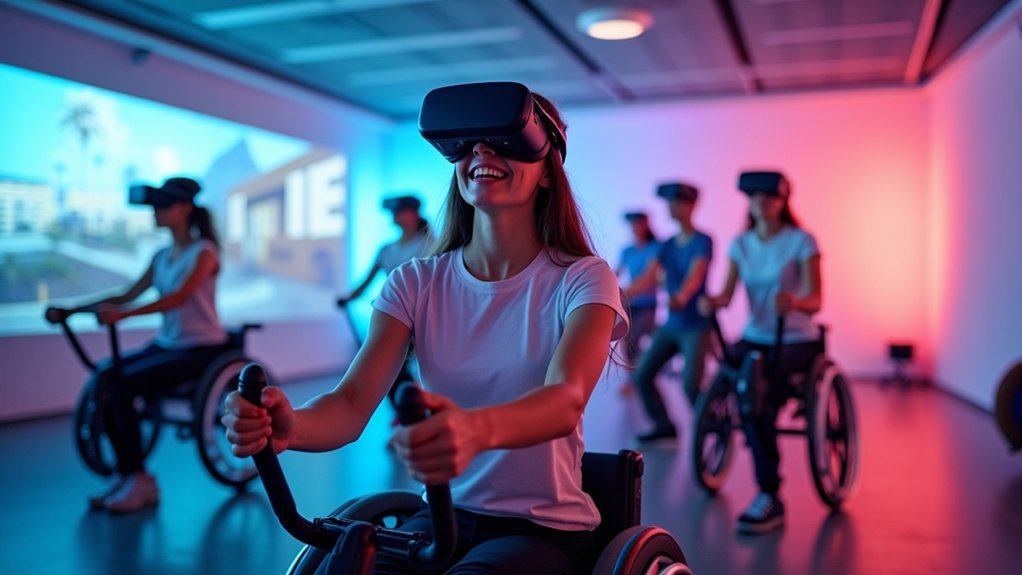
Innovation in adaptive VR fitness technology continues to accelerate, promising revolutionary advancements for individuals with cognitive disabilities. The integration of haptic feedback suits will soon provide enhanced tactile sensations during workouts, creating more immersive and engaging experiences.
You’ll soon benefit from these groundbreaking developments:
- AI-powered virtual coaches that adapt in real-time to your specific needs, offering personalized guidance and adjusting difficulty based on your performance.
- Lightweight, comfortable headsets with integrated biometric monitoring to track your health metrics while you exercise.
- Hybrid AR/VR experiences that blend virtual elements with your physical environment, allowing for unique fitness routines that can be performed anywhere.
These innovations will make adaptive fitness more accessible, engaging, and effective for users with cognitive disabilities. Multiplayer features are increasingly fostering supportive environments where users can experience the motivation and accountability of community-driven fitness.
Frequently Asked Questions
What Age Is Too Young or Too Old for VR Fitness?
You’ll find VR fitness suitable from ages 8-10 (with adult supervision) to seniors who are physically able. There’s no strict upper age limit, but you should consider individual health conditions and comfort levels.
Are Insurance Providers Covering VR Fitness Equipment for Cognitive Rehabilitation?
Insurance coverage for VR fitness equipment in cognitive rehabilitation is limited. You’ll find some providers like Aetna cover it for specific conditions, but most insurers, including Medicare, don’t fully reimburse these emerging technologies yet.
How Does VR Fitness Compare to Traditional Cognitive Rehabilitation Methods?
VR fitness offers you more immersive and engaging experiences than traditional cognitive rehabilitation methods. You’ll likely find it more motivating, adaptable to your specific needs, and accessible from home, though it currently has less research backing.
Can VR Fitness Trigger Seizures in Neurologically Vulnerable Individuals?
Yes, VR fitness can trigger seizures in neurologically vulnerable individuals. If you have photosensitive epilepsy, you’ll face risks from flashing lights, rapid movements, and immersive visual stimuli in VR environments.
What Certification Do Professionals Need to Implement VR Cognitive Fitness Programs?
You’ll need a Master’s degree in a mental health discipline, professional licensing, and specialized certifications like CBIS. Continuing education in VR technology and brain injury specialization will enhance your qualifications for implementing cognitive fitness programs.
In Summary
VR fitness games are revolutionizing therapy for cognitive disabilities. You’ve seen how these immersive experiences combine physical activity with brain training in accessible, engaging ways. By embracing this technology, you’re opening doors to improved cognitive function, physical health, and independence. Whether you’re a user or caregiver, VR fitness offers personalized, measurable progress. As adaptive technology advances, the potential benefits for cognitive disabilities will only grow.

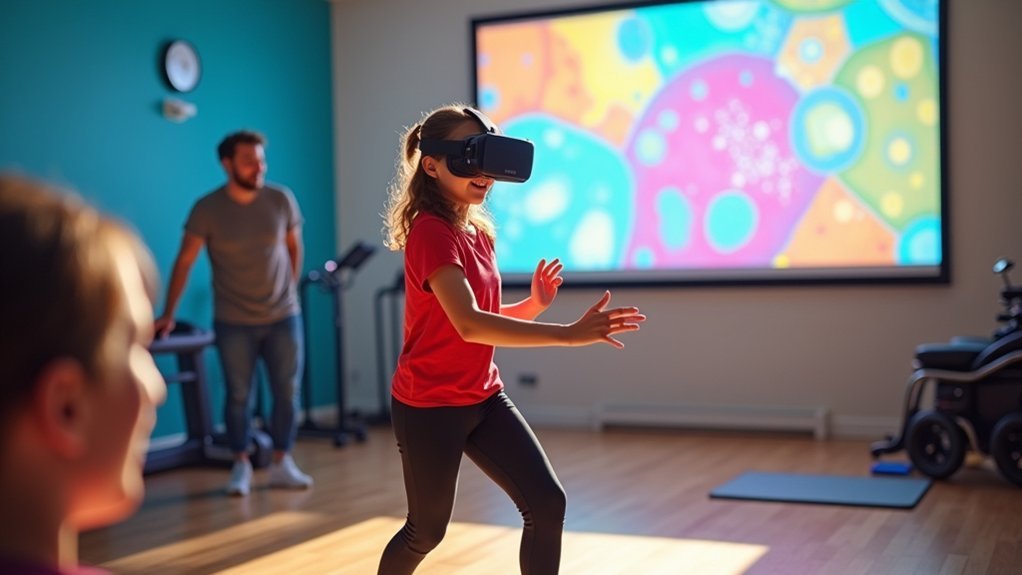



Leave a Reply